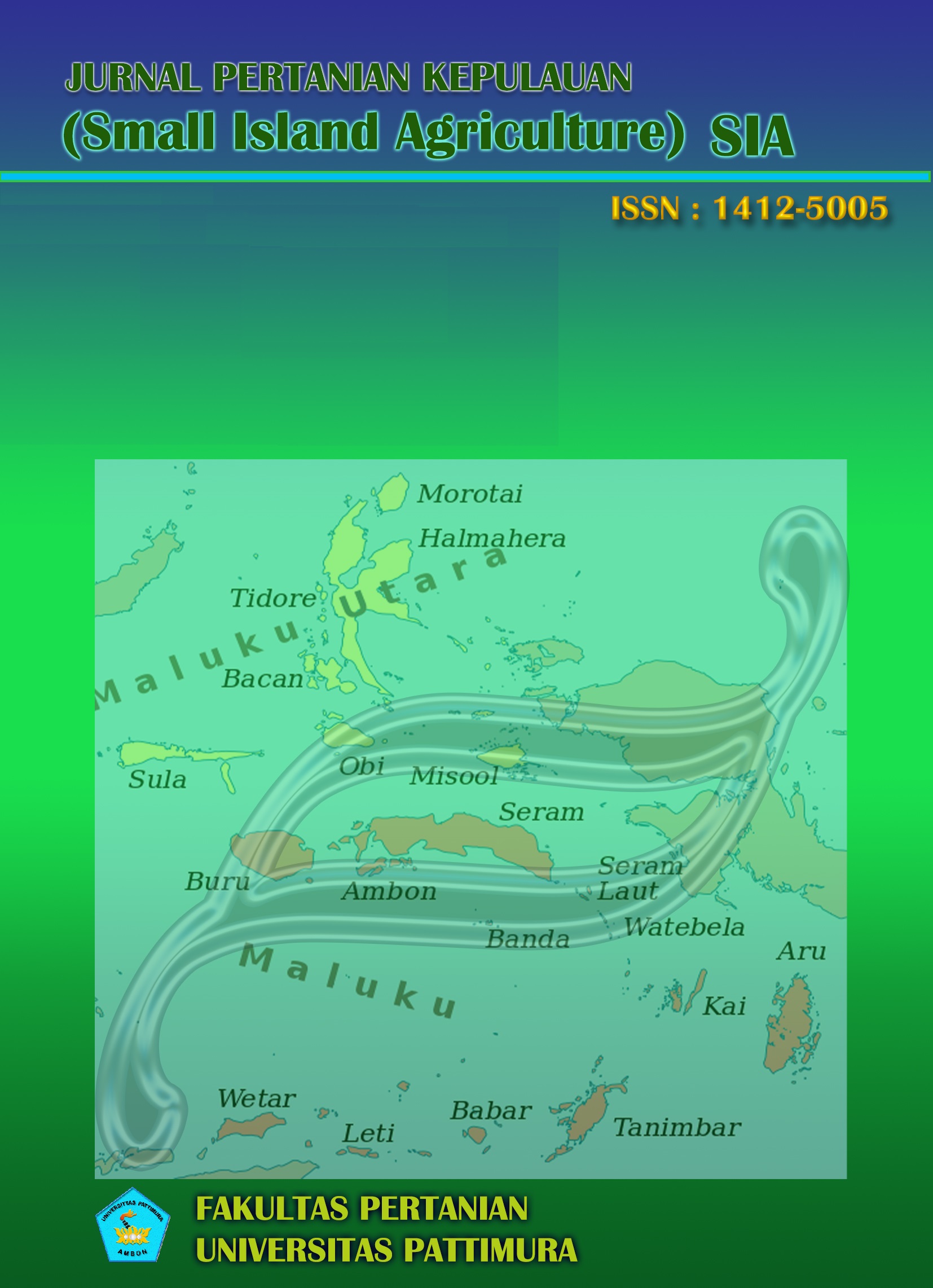Karakteristik Tanah Di bawah Tegakan Sagu pada Berbagai Kondisi Genangan di Kecamatan Taniwel Timur Kabupaten Seram Bagian Barat
Abstract
Soil characteristics in sago land show hydro-morphic character as well as gleization symptoms because it is periodically influenced by wet and dry conditions. Differences in soil characteristics formed are observed under sago stands in different inundation conditions and their effect on the units of soil formed. This study aims to identify the characteristics of the soil under the sago stand in various conditions of inundation. The survey and sampling were conducted at four sample locations and observed three different environmental conditions: not inundated, permanently inundated, and temporarily inundated. The results showed that there were significant differences between the four research sample locations, both soil and hydrological parameters, such as the number of layers, soil texture, soil color, pH, soil consistency, organic matter, and inundation conditions. This characteristic affected the soil under the sago standing environment. The condition of the depth of groundwater was rather deep, and the inundation was temporarily stagnant. Thus according to the observations, there was not too significant a difference from the soils; only differences in the production of sago plants were found.
Downloads
References
Association Of Offical Analytical Chemists (AOAC). (2006). Official Methods Of Analysis
(18th Ed.). Association Of Official Analytical Chemists.
Blakely, J., & Bade, D. . (1998). Ilmu Peternakan. Gajah Mada University Press. Darmono. (1999). Tatalaksana Usaha Sapi Kereman. Kanisius.
Ensiminger. (2008). Buku Ajar Teknologi Pemanfaatan Limbah Untuk Pakan. Laboratorium Makanan Ternak Fakultas Peternakan Universitas Jambi.
Hafes, E. (2000). Metode Analisis Proksimat. Erlangga.
Haryanto, B., & Djayanegara, A. (1993). Pemenuhan Kebutuhan Zat-Zat Makanan Ternak Ruminansia Kecil. Sebelas Maret University Press.
Joseph, G. (2007). Suplementasi Sabun Kalsium Dalam Pakan Ternak Ruminansia Sebagai Sumber Energi Alternatif Untuk Meningkatkan Produksi Daging Yang Berkualitas. Institut Pertanian Bogor.
Kurijasanti. (2016). Efek Sitotoksik In-Vitro Dari Ekstrak Buah Mahkota Dewa (Phaleria Macrocarpo) Terhadap Kultur Sel Kanker Myeloma. J. Penelit. Med. Eksakta, 7(1), 48–54.
Lemus, R. (2013). What Are The Mineral Concentrations Of Forages? Forages News. Cooperative Extension Services. Mississippi State University).
Mathius, I., Gaga, I., & Sutama, I. (2002). Kebutuhan Kambing PE Jantan Muda Akan Energi Dan Protein Kasar. JITV, 7(2), 99–109.
Muelen. (2000). Pemanfaatan Protein Dan Energi Terlindungi Untuk Meningkatkan Efisiensi Penggunaan Pakan (P. 2). L-Hasil Penelitian Peternakan. Balai Penelitian Ternak. Bogor.
Parakkasi, A. (1999). Ilmu Nutrisi Dan Makanan. UI Press.
Rangkuti. (2008). Pedoman Praktis Beternak Kambing-Domba Sebagai Ternak Potong.
Puslitbangnak, Departemen Pertanian.
Retnani, Y., Permana, I., Kumalasari, N., & Taryati. (2015). Teknik Membuat Biskuit Pakan Ternak Dari Limbah Pertanian. Penebar Swadaya.
Sarwono, B. (2008). Beternak Kambing. Penebar Swadaya. Siregar, S. (1994). Ransum Ternak Ruminansia. Penebar Swadaya.
Soeparno. (2009). Ilmu Dan Teknologi Daging (Edisi Kedu). Gajah Mada University Press. Syarif, R., & Halid, H. (1993). Teknologi Penyimpanan Pangan. CV Arcan.
Umela, S. (2016). FERMENTASI KULIT BUAH KAKAO (Theobroma Cacao) SEBAGAI BAHAN PAKAN TERNAK. Jurnal Technopreneur, 42, 116–122.





.png)


